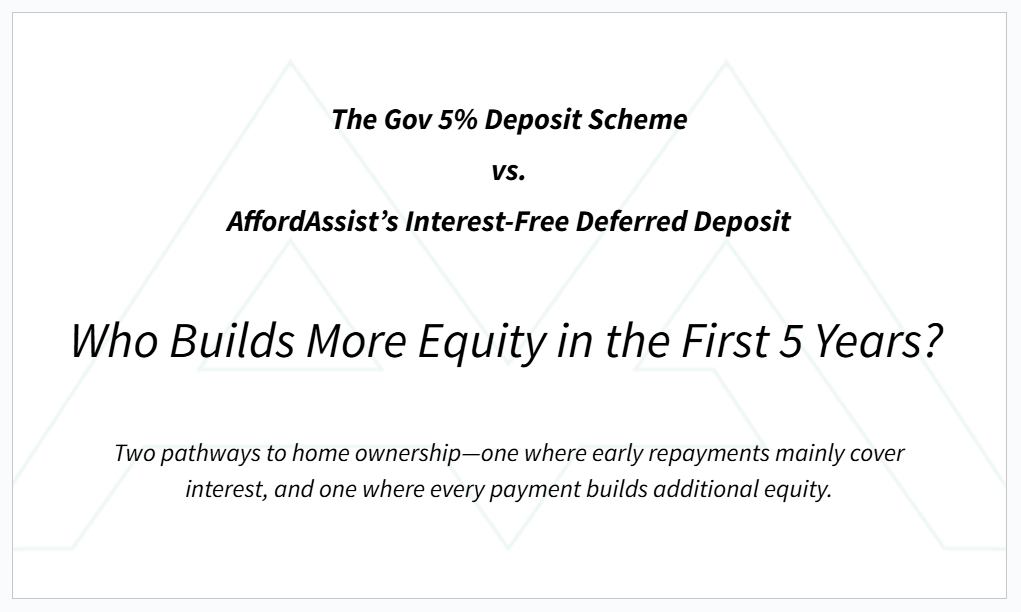The Gov 5% Deposit Scheme vs. AffordAssist’s Interest-Free Deferred Deposit: Who Builds More Equity in the First 5 Years?
Two pathways to home ownership—one where early repayments mainly cover interest, and one where every payment builds additional equity.
Dear All
When it comes to entering the property market, the path you choose can make a huge difference to how quickly you build equity. The government’s 5% deposit scheme lowers the barrier to entry, but many buyers find that in the first five years, a large portion of their repayments goes toward interest rather than principal.
AffordAssist offers a different path. With its interest-free deferred deposit solution, buyers can secure a home loan with as little as a 1% partial deposit upfront, while deferring the remaining deposit—interest-free—for typically up to 60 months. From day one, they enjoy 100% title ownership, and every repayment builds real equity rather than being absorbed by interest.
This article compares the two approaches and highlights how early repayment strategies can shape long-term financial outcomes.
- How the Government 5% Deposit Scheme Works
The government-backed scheme allows eligible buyers to enter the market with just a 5% deposit, often supported by a guarantor or mortgage insurance. While this reduces the initial deposit burden, the standard mortgage repayment structure means that a significant portion of early payments goes toward interest, especially on a high loan-to-value ratio (LVR) loan of 95%.
Key point: In the first five years, only a small fraction of the principal is typically paid down, meaning homebuyers build limited equity while still exposed to interest rate fluctuations.
- How AffordAssist’s Interest-Free Deferred Deposit Solution Works
AffordAssist provides a unique approach where a portion of the deposit is deferred interest-free. Importantly, every repayment made—whether principal or deposit—directly increases the buyer’s equity in the property. This method separates the deposit accumulation from repayment capacity, giving buyers a faster, structured path to ownership without extending their debt unnecessarily.
Key point: Buyers actively grow equity from day one, unlike in traditional high-LVR loans where early payments primarily cover interest.
- Comparing Equity Growth: A 5-Year Perspective
The following example provides a general comparison, based on an $800,000 principal and interest home loan versus the AffordAssist interest-free payment plan:
- Gov 5% Deposit Scheme: After 5 years, roughly $50,000—around 6.25%—has been paid toward the principal.
- AffordAssist Deferred Deposit: Every repayment contributes directly to the principal. Over the same period, buyers can build 10% or more in equity, accelerating genuine ownership and long-term wealth creation.
- The Bigger Picture: Why Early Equity Matters
Equity is more than a number on paper—it represents financial security, borrowing power, and flexibility. By prioritising principal reduction from day one, AffordAssist empowers buyers to:
- Reduce interest exposure over time
- Build genuine ownership faster
- Create long-term wealth without waiting decades to save a larger deposit
Conclusion
Both the government 5% deposit scheme and AffordAssist’s deferred deposit solution make home ownership more accessible. However, for buyers focused on building real equity quickly, AffordAssist’s interest-free deferred deposit solution offers a clear advantage. Every payment is a step toward ownership, not just an interest obligation, making the first five years—and beyond—more financially rewarding.
Regards
AA
B2B – AffordAssist facilitates and oversees the governance process. Are you a mortgage broker, lender, developer, real estate agent, affordable housing advocate, or housing minister? We welcome your collaboration. Join us in our mission to expand access to home ownership. Together, we can make a lasting impact.

